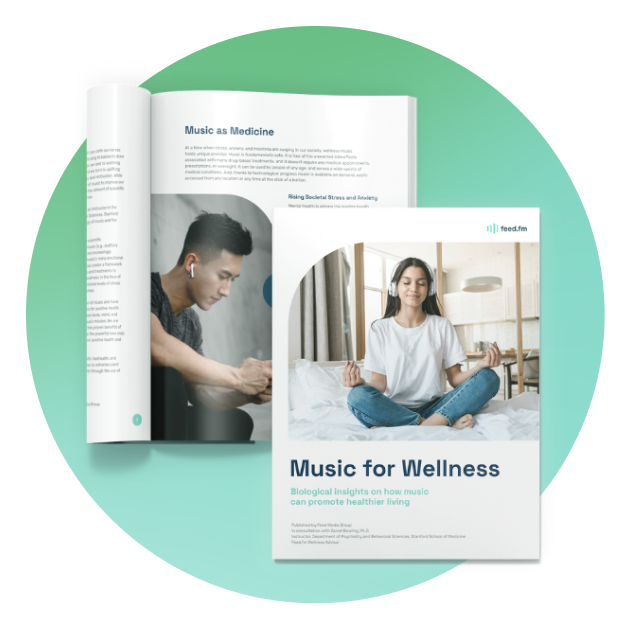Preview
Music for Wellness
Welcome to a short preview of the Feed.fm 2024 Guide to Music Licensing. Start reading below, or click here to access the full guide.


Introduction
For many of us, the knowledge that music can calm our nerves and improve our mood is intuitive: parents sing to babies to draw out smiles and help them settle into sleep, we look to soothing music to help us calm down and relax, and we turn to uplifting music to pick us up when we need energy and motivation. While at times it may feel like magic, the ability of music to improve our lives is increasingly well-researched and the amount of scientific energy focused on music continues to grow.
We’ve partnered with Dr. Daniel Bowling, an instructor in the Department of Psychiatry and Behavioral Sciences, Stanford School of Medicine, to dive into the biology of music and the science of “Music as Medicine.”
In this white paper, you’ll learn about the scientific breakthroughs in the biological study of music (e.g., auditory neuroscience and “biomusicology”) that are increasingly documenting the brain-based reality of music’s many emotional and physiological benefits. These advances create a framework for the use of music-based interventions and treatments to radically improve our mental health and wellness in the face of expanding challenges, including dysfunctional levels of stress and anxiety, depressed mood, and poor sleep.
We’ve always believed deeply in the power of music and have been researching and programming music for positive health benefits for years. This connection between body, mind, and music lies at the heart of Feed Media Group’s mission. We are driven to enable everyone to experience the proven benefits of music, and we’re incredibly excited to see the powerful new crop of apps and digital experiences focused on positive health and wellness outcomes.
Apps for relaxation and sleep, digital health, telehealth, and overall well-being offer novel opportunities to enhance users’ experiences and even improve their health through the use of carefully curated soundtracks.

Lauren Pufpaf
President, COO & Co-Founder, Feed Media Group
The 2024 Guide to Wellness Music is published by Feed Media Group in consultation with Daniel Bowling, Ph.D. Instructor, Department of Psychiatry and Behavioral Sciences, Stanford School of Medicine Feed.fm Wellness Advisor

Music as medicine
At a time when stress, anxiety, and insomnia are surging in our society, wellness music holds unique promise. Music is fundamentally safe. It is free of the unwanted side effects associated with many drug-based treatments, and it doesn’t require any medical appointments, prescriptions, or oversight. It can be used by people of any age, and across a wide variety of medical conditions. And, thanks to technological progress music is available on demand, easily accessed from any location at any time at the click of a button.
Rising Societal Stress and Anxiety
Mental health is among the leading health concerns in the U.S. and around the world, affecting people across demographic spectra. In a 2022 study of U.S. adults by the American Psychological Association, 76% of respondents reported negative health effects due to stress in the prior month, including headaches, fatigue, anxiety, and depression. Causes of stress include worries about civil liberties, inflation, the climate crisis, and gun violence.
Members of Gen Z bear an extraordinary stress burden, with 62% of women and 51% of men reporting being completely overwhelmed by stress on most days.2 Following closely on the heels of the health, educational, and social stresses of the COVID-19 pandemic, young people are suffering from financial stresses, as well as difficult social environments and inadequate mentoring in their workplaces.7
These figures can be compared with the background rate of mental illness in the U.S. as calculated by the National Institute of Mental Health. In 2021, there were an estimated 57.8 million adults with any mental illness, representing 22.8% of all U.S. adults.21
76% of U.S. adults surveyed reported negative health effects due to stress.
Clinical Applications of Music
As the societal burden of stress and mental health needs has grown, so has interest in the power of music as medicine, as well as research into the ways in which music can be directed to ease this burden and enhance people’s lives.
The new interest and research into the use of music as a therapeutic tool builds on the foundation of treatments developed in the field of music therapy. The modern discipline of music therapy began in the 1940s, with roots in the treatment of traumatized war veterans and children with special needs. While there has been steady progress over the ensuing decades, and the use of music therapy has massively expanded, clear demonstrations of efficacy have been complicated due to variation in practice, changes in how we think about mental health, and the challenges of performing music-based studies in the context of randomized double-blind, placebo-controlled clinical trials (e.g., it’s hard to blind someone to the fact that they’re listening to music!). However, this has begun to change over the last several decades as new studies and large-scale reviews of existing research have validated many of the most significant benefits of music to our health.
Interest in the scientific and clinical applications of music has been steadily growing: in the year 2000, there were 500 scientific research articles on the topic of music; in 2020, there were 1,000; and in 2022, almost 3,000. This increase in research has led to the creation of a new discipline at the intersection of music and human biology: “biomusicology”, which draws on and synthesizes work across auditory and social neuroscience, the psychological study of music, music cognition, acoustics, and
signal processing.
Progress has been aided by technological innovation in brain imaging, particularly fMRI (functional Magnetic Resonance Imaging), which has allowed scientists to measure activity throughout the brain during musical stimulation.
Unlock the full guide
Submit the form below to unlock the complete guide to wellness music.

The science behind wellness music
Scientists, artists, and enthusiasts have long understood that music is an important and integral aspect of human nature. Scientific and technological advances have developed our understanding about how many of the features of music that we know and love—its emotional effects, its capacity to deliver rewards, and its ability to bring people together—are rooted in specific mechanistic effects of music on the brain.
Importantly, the discoveries underlying this progress have been made by focusing on “musicality” rather than music itself. A common (and reasonable) question when it comes to the biological effects of music is, “doesn’t everybody like something different?” After all, music is a cultural phenomenon of ever-expanding diversity; some people prefer folk music while others choose death metal. But music and its effects are highly structured. Biomusicology focuses on what’s held in common: human musicality, the genetically constrained and reliably developing set of capacities that allow us to produce and perceive music.
There are at least four areas of human musicality that are of major importance in understanding applications of music for wellness: tonality, rhythm, reward, and social connection.5

Efficacy of music as medicine
The physiological and psychological effects of music are real and measurable. In addition to the meta-analyses described above, there is strong evidence that music has clinically relevant benefits in a number of other contexts, including rehabilitation after neural injury,23 exercise,24 sleep,8,10,14 dementia,26 psychosis,15 and autism,11 among others.3,4,29 In most of these cases, the benefits of music are apparent in direct comparisons of musical interventions to standard care (e.g., other behavioral or drug therapies), or when added to standard care. This is particularly relevant given that many standard behavioral and drug-based approaches require major time investments, are associated with unpleasant side effects, and/or have limited efficacy.13
As a society, we are only beginning to tap the potential of music to systematically improve health and wellness. We tend to think of music mainly as a form of art or entertainment, with consumption being driven by an industry that heavily favors commercial success and marketability.
But what might be possible if we expand our appreciation of music to include all that it can do for our health and well-being?
Unlock the full guide
Submit the form below to unlock the complete guide to wellness music.
Sources:
1. Aalbers, S., Fusar-Poli, L., Freeman, R., Spreen, M., Ket, J., Vink, A., Maratos, A., Crawford, M., Chen, X., & Gold, C. (2017). Music therapy for depression (review). Cochrane Database Syst. Rev. CD004517 doi:10.1002/14651858.cd004517.
2. American Psychological Association. (2022, October). Stress in America 2022: Concerned for the future, beset by inflation. https://www.apa.org/news/press/releases/stress/2022/concerned-future-inflation
3. Bibb, J., Castle, D. & Newton, R. (2015). The role of music therapy in reducing post meal related anxiety for patients with anorexia nervosa. J. Eat. Disord., 3, 1–6.
4. Bodeck, S., Lappe, C. & Evers, S. (2015). Tic-reducing effects of music in patients with Tourette’s syndrome: Self-reported and objective analysis. J. Neurol. Sci., 352, 41–47. doi: 10.1016/j.jns.2015.03.016.
5. Bowling, D. L. (2023). Biological principles for music and health. PsyArXiv. March 29. psyarxiv.com/fxsnz.
6. Bowling, D. L., Purves, D. & Gill, K. Z. (2018). Vocal similarity predicts the relative attraction of musical chords. Proc. Natl. Acad. Sci., 115, 216–221.
7. Carnegie, M. (2023, February). Are Gen Z the most stressed generation in the workplace? BBC. https://www.bbc.com/worklife/article/20230215-are-gen-z-the-most-stressed-generation-in-the-workplace
8. Dickson, G. T. & Schubert, E. (2020). Music on Prescription to Aid Sleep Quality: A Literature Review. Front. Psychol., 11, 1695. doi: 10.3389/fpsyg.2020.01695.
9. Doelling, K. B., Florencia Assaneo, M., Bevilacqua, D., Pesaran, B. & Poeppel, D. (2019). An oscillator model better predicts cortical entrainment to music. Proc. Natl. Acad. Sci. U. S. A., 116(20), 10113–10121. doi: 10.1073/pnas.1816414116.
10. Feng, F., Zhang, Y., Hou, J., Cai, J., Jiang, Q., Li, X., Zhao, Q., & Li, B. (2018). Can music improve sleep quality in adults with primary insomnia? A systematic review and network meta-analysis. International Journal of Nursing Studies, 77, 189–196.doi.org/10.1016/j.ijnurstu.2017.10.011.
11. Geretsegger, M., Elefant, C., Mössler, K. A. & Gold, C. (2014). Music therapy for people with autism spectrum disorder. Cochrane Database Syst. Rev. CD004381. doi:10.1002/14651858.CD004381.pub3
12. Gioia, T. (2006). Work songs. Duke University Press Books.
13. InformedHealth.org [Internet]. Cologne, Germany: Institute for Quality and Efficiency in Health Care (IQWiG); Depression: How effective are antidepressants? [Updated 2020 Jun 18]. Available from: https://www.ncbi.nlm.nih.gov/books/NBK361016/
14. Jespersen, K.V., Pando-Naude, V., Koenig, J., Jennum, P., Vuust, P. (2022 ). Listening to music for insomnia in adults. Cochrane Database Syst Rev., 8, CD010459. doi: 10.1002/14651858.CD010459.pub3. PMID: 36000763; PMCID: PMC9400393.
15. Jia, R., Liang, D., Yu, J., Lu, G., Wang, Z., Wu, Z., Huang, H., & Chen, C. (2020). The effectiveness of adjunct music therapy for patients with schizophrenia: A meta-analysis. Psychiatry Res., 293.
16. Juslin, P. N. & Laukka, P. (2003). Communication of emotions in vocal expression and music performance: different channels, same code? Psychol. Bull., 129, 770–814.
17. Kühlmann, A. Y., de Rooij, A., Kroese, L. F., van Dijk, M., Hunink, M. G., Jeekel, J. (2018). Meta-analysis evaluating music interventions for anxiety and pain in surgery. Br J Surg., 105(7):773–783. doi: 10.1002/bjs.10853. Epub 2018 Apr 17. PMID: 29665028; PMCID: PMC6175460.
18. Large, E. W. & Snyder, J. S. (2009). Pulse and meter as neural resonance. Ann. N. Y. Acad. Sci., 1169, 46–57. doi: 10.1111/j.1749-6632.2009.04550.x.
19. Lu, G., Jia, R., Liang, D., Yu, J., Wu, Z., Chen, C. (2021). Effects of music therapy on anxiety: A meta-analysis of randomized controlled trials. Psychiatry Res., 304:114137. doi: 10.1016/j.psychres.2021.114137. Epub 2021 Jul 25. PMID: 34365216.
20. Mallik, A., Chanda, M. L., Levitin, D. J. (2017). Anhedonia to music and mu-opioids: Evidence from the administration of naltrexone. Sci. Rep., 7:41952. doi: 10.1038/srep41952.
21. National Institute of Mental Health. (2023, March). Mental illness. https://www.nimh.nih.gov/health/statistics/mental-illness
22. Poeppel, D. & Assaneo, M. F. (2020). Speech rhythms and their neural foundations. Nat. Rev. Neurosci. 21, 322–334.
23. Särkämö, T., Tervaniemi, M., Laitinen, S., Forsblom, A., Soinila, S., Mikkonen, M., Autti, T., Silvennoinen, H., Erkkilä, J., Laine, M., Peretz, I., & Heitanen, M. (2008). Music listening enhances cognitive recovery and mood after middle cerebral artery stroke. Brain, 131, 866–876. doi: 10.1093/brain/awn013.
24. Schaffert, N., Janzen, T. B., Mattes, K. & Thaut, M. H. (2019). A review on the relationship between sound and movement in sports and rehabilitation. Front. Psychol., 10, 1–20.
25. Tang, Q., Huang, Z., Zhou, H. & Ye, P. (2020). Effects of music therapy on depression: A meta-analysis of randomized controlled trials. PLoS One, 15(11). doi: 10.1371/journal.pone.0240862.
26. Tang, Q., Zhou, Y., Yang, S., Thomas, W.K., Smith, G.D., Yang, Z., Yuan, L., & Chung, J. (2018). Effect of music intervention on apathy in nursing home residents with dementia. Geriatr. Nurs., 39(4), 471–476.
27. Terhardt, E. (1984). The concept of musical consonance: a link between music and psychoacoustics. Music Percept., 1, 276–295.
28. van Noorden, L. & Moelants, D. (1999). Resonance in the perception of musical pulse. J. New Music Res., 28(1), 43–66.
29. Wu, Q., Chen, T., Wang, Z., Chen, S., Zhang J., Bao, J., Su, H., Tan, H., Jiang, H., Du, J., & Zhao, M. (2020). Effectiveness of music therapy on improving treatment motivation and emotion in female patients with methamphetamine use disorder: A randomized controlled trial. Subst. Abus., 41(4), 493–500.
30. Zatorre, R. J. (2015). Musical pleasure and reward: Mechanisms and dysfunction. Ann. N. Y. Acad. Sci., 1337, 202–211.